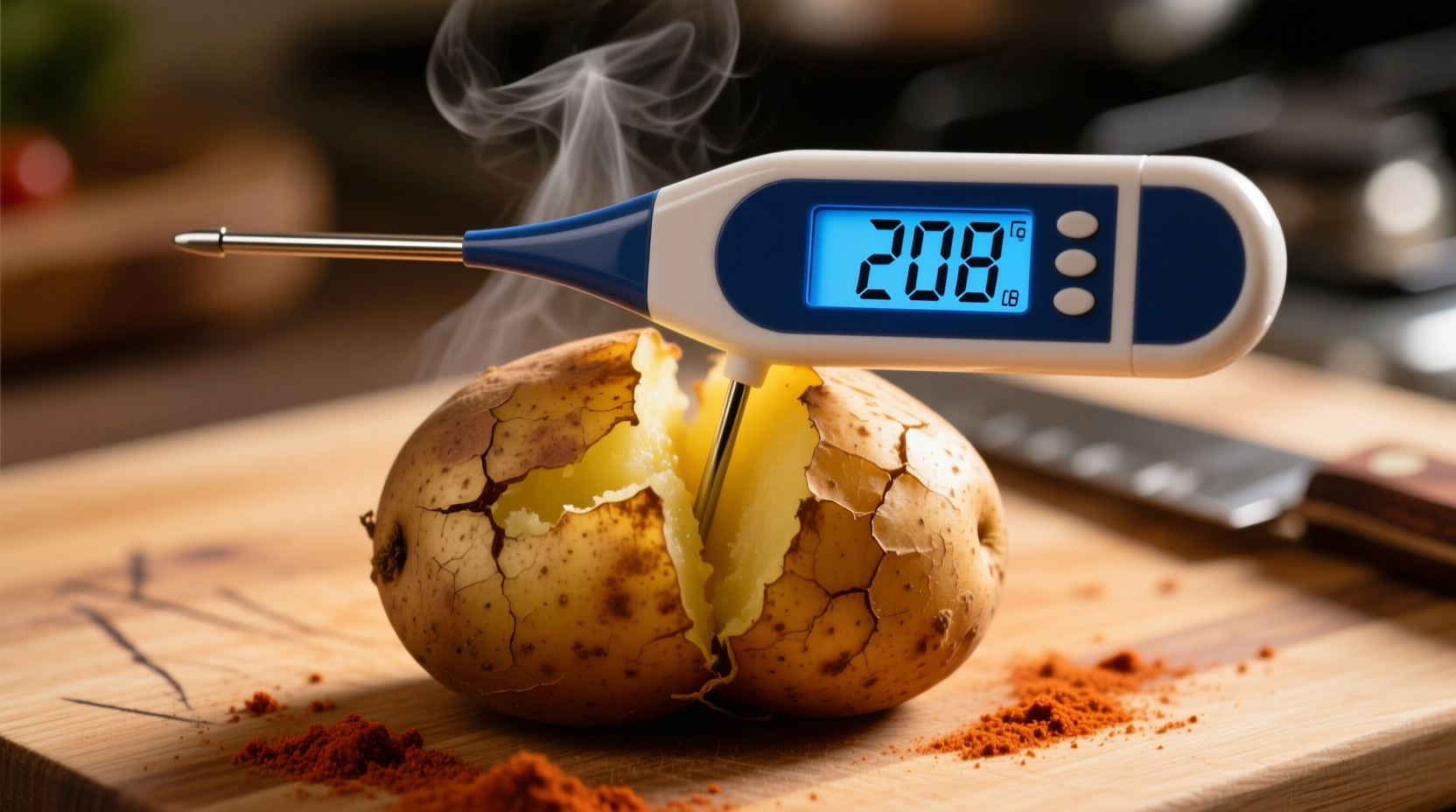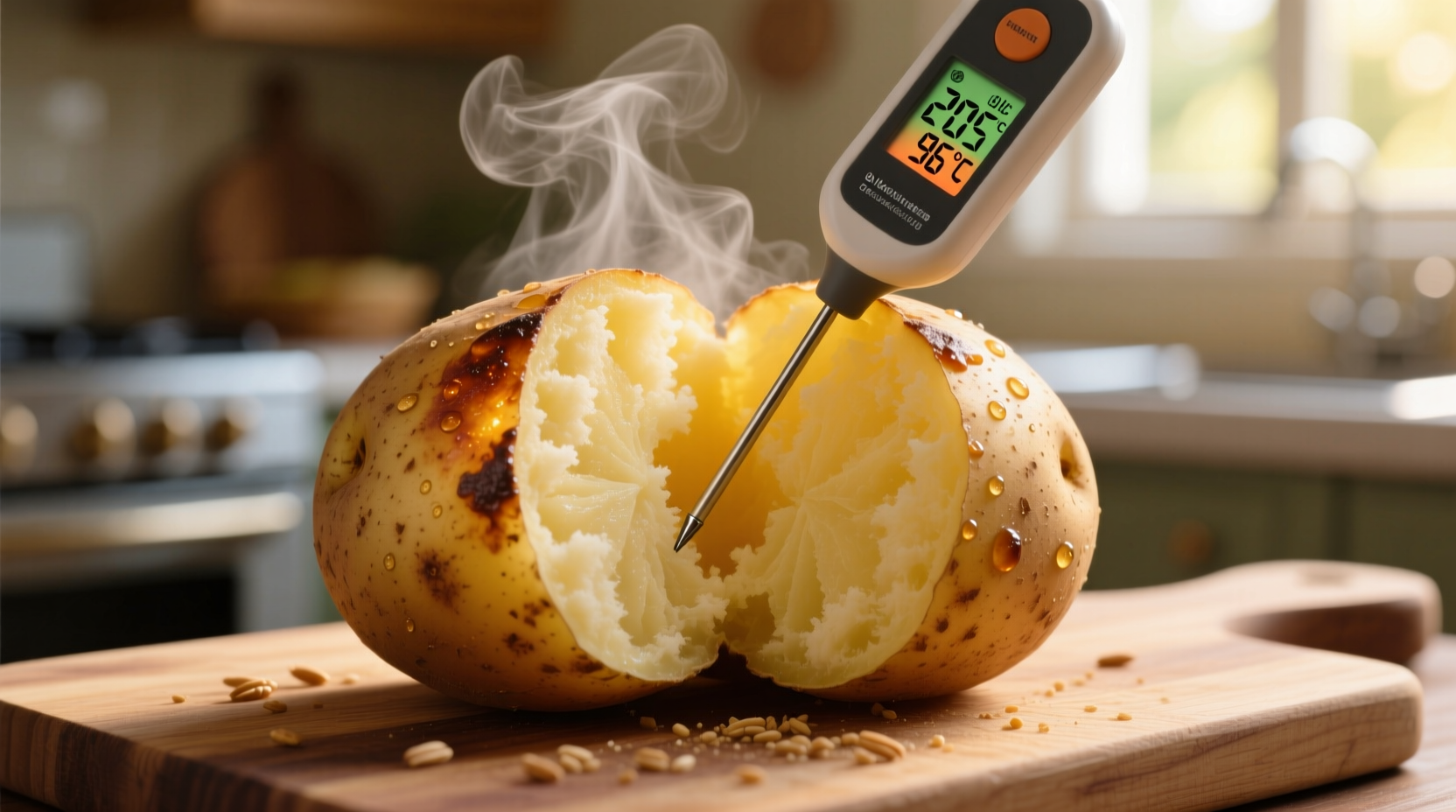The perfect internal temperature for a baked potato is 205-210°F (96-99°C). This precise range ensures complete starch gelatinization for a light, fluffy interior while maintaining structural integrity. Measuring with a reliable instant-read thermometer guarantees consistent results every time, eliminating guesswork in potato preparation.
Have you ever cut into a baked potato only to find a dense, undercooked center? Or worse—a dried-out, overcooked mess? The secret to consistently perfect baked potatoes isn't cooking time or oven temperature alone. It's monitoring the internal temperature, the single most reliable indicator of doneness. Professional kitchens and food scientists agree: when your potato reaches 205-210°F (96-99°C), you've hit the sweet spot for ideal texture.
Why Internal Temperature Matters More Than Time
Potato cooking isn't about minutes on the clock—it's about starch transformation. As potatoes heat, their starch granules absorb water and swell in a process called gelatinization. This scientific transformation creates that signature fluffy texture we love. But it doesn't happen magically at a specific time.
Factors like potato size, starting temperature, oven accuracy, and even altitude dramatically affect cooking duration. A small 6-ounce potato might reach perfect doneness in 45 minutes, while a large 12-ounce specimen could need 75 minutes at the same oven setting. Relying solely on time leads to inconsistent results.
| Temperature Range | Starch Transformation | Resulting Texture |
|---|---|---|
| 160-180°F (71-82°C) | Initial gelatinization begins | Firm, slightly waxy center |
| 180-200°F (82-93°C) | Partial gelatinization | Mostly cooked but dense center |
| 205-210°F (96-99°C) | Complete gelatinization | Perfectly fluffy throughout |
| 215+°F (102+°C) | Over-gelatinization | Dry, crumbly texture |
This temperature-dependent transformation explains why visual cues alone can't guarantee perfection. The USDA's Food Safety and Inspection Service confirms that proper internal temperature is critical for both food safety and quality in starchy vegetables (USDA FSIS).
How to Accurately Measure Potato Temperature
Using the right tool and technique makes all the difference:
- Choose the right thermometer: An instant-read digital thermometer with a thin probe (like ThermoWorks' SplashProof) provides the fastest, most accurate reading
- Insert correctly: Slide the probe horizontally through the potato's side, aiming for the geometric center
- Check multiple spots: For larger potatoes, verify temperature in 2-3 locations to ensure even cooking
- Wait for stabilization: Hold the probe in place until the reading stops fluctuating (usually 5-10 seconds)
Avoid common mistakes like inserting vertically (which often hits cooler skin temperature) or checking too close to the surface. Remember that potatoes continue cooking after removal from heat—the temperature can rise 5-10°F during resting.

Temperature Guidelines for Different Cooking Methods
While the target internal temperature remains consistent, cooking methods affect how you achieve it:
- Traditional oven baking (400°F/204°C): Typically requires 50-75 minutes for medium potatoes. The 205-210°F target applies directly.
- Air fryer (390°F/199°C): Cooks 25-30% faster. Check temperature 10-15 minutes earlier than oven times.
- Convection oven: Reduce standard baking time by 25% while maintaining the same temperature target.
- Slow baking (325°F/163°C): Takes 90-120 minutes but produces exceptionally fluffy results when reaching 208°F.
Research from America's Test Kitchen demonstrates that lower-temperature, longer-duration baking allows more complete starch conversion at the ideal temperature threshold, yielding superior texture (America's Test Kitchen).
Contextual Factors Affecting Perfect Potato Temperature
Several variables influence your ideal target temperature:
- Potato variety: Russets (Idaho) reach optimal fluffiness at 208°F, while denser Yukon Golds may need 203°F for best results
- Starting temperature: Refrigerated potatoes require 10-15°F higher target to compensate for thermal shock
- Altitude: Above 3,000 feet, increase target by 5°F due to lower boiling point
- Desired texture: For extra-fluffy results, pull at 205°F; for firmer texture (better for potato salads), remove at 200°F
Food science research published in the Journal of Food Engineering confirms that potato starch gelatinization completes between 200-210°F, with optimal water absorption occurring at 208°F (Journal of Food Engineering).
When Temperature Isn't Enough: Supplemental Doneness Indicators
While temperature is primary, these secondary indicators confirm perfection:
- Skin appearance: Deep golden brown with slight wrinkling (not blackened)
- Texture test: Gently squeeze—should yield slightly but maintain shape
- Steam release: Visible steam when pierced with fork
- Internal appearance: Uniformly creamy white with no translucent patches
Remember that visual cues vary significantly by potato variety and cooking method. A perfectly cooked sweet potato, for example, reaches optimal texture at 200-205°F—5°F lower than russets due to different starch composition.
Troubleshooting Common Temperature Issues
Encountering problems? Check these temperature-related solutions:
- Dense center despite long cooking: Your oven runs cool—verify with oven thermometer and increase target to 212°F
- Dry, crumbly texture: Overheated beyond 212°F—remove at 207°F next time
- Uneven cooking: Rotate potato halfway through baking and check multiple internal points
- Long cooking time: Prick skin deeply with fork before baking to allow steam escape
Professional chefs at the Culinary Institute of America emphasize that precise temperature control separates consistently excellent baked potatoes from hit-or-miss results in their foundational cooking courses (CIA Curriculum).
Perfect Potato Temperature Timeline
Understanding the temperature progression helps anticipate doneness:
- 140°F (60°C): Initial starch swelling begins
- 165°F (74°C): Cell walls start breaking down
- 185°F (85°C): Significant moisture release begins
- 200°F (93°C): Starch gelatinization accelerates rapidly
- 205-210°F (96-99°C): Complete transformation to fluffy texture
- 215°F+ (102°C+): Excessive moisture loss begins
This progression explains why the final 5°F makes such a dramatic difference in quality. The critical transformation happens in that narrow window between 200-210°F where starches fully absorb moisture and expand.
Final Temperature Tips for Potato Perfection
For consistently flawless baked potatoes:
- Always use a calibrated instant-read thermometer—don't guess
- Let potatoes rest 5-7 minutes after reaching target temperature
- For meal prep, remove at 205°F as carryover cooking will reach 208°F
- Store leftovers at or below 40°F and reheat to 165°F for food safety
Mastering baked potato internal temperature transforms a simple side dish into a consistently perfect accompaniment. Whether you're cooking for weeknight dinners or holiday feasts, that precise 205-210°F range delivers restaurant-quality results every time.











 浙公网安备
33010002000092号
浙公网安备
33010002000092号 浙B2-20120091-4
浙B2-20120091-4